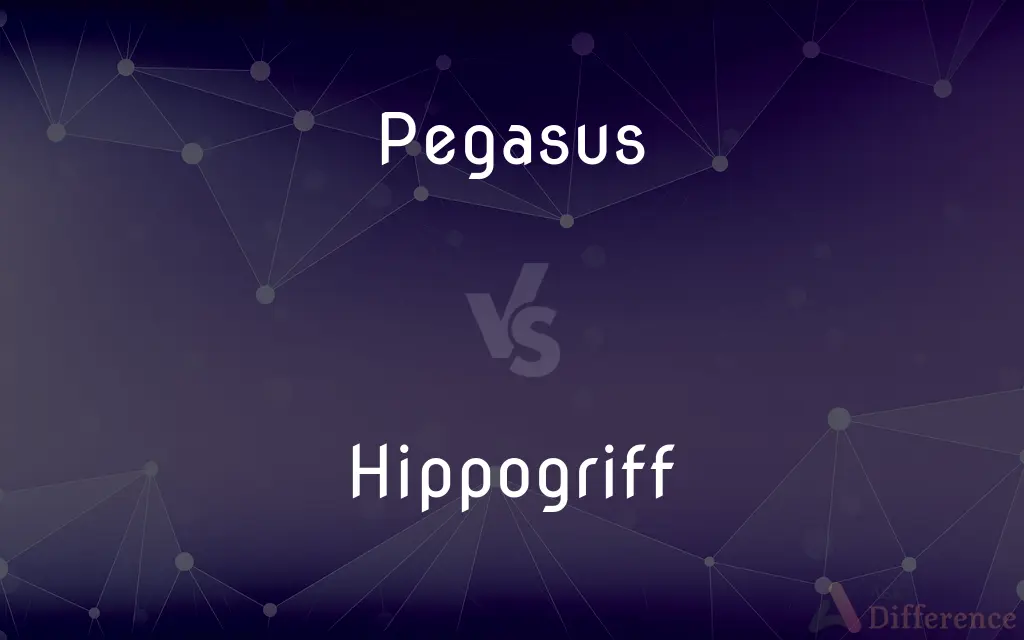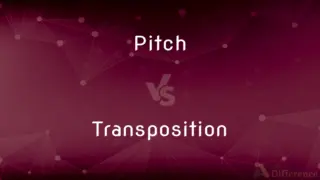Pegasus vs. Hippogriff — What's the Difference?
By Fiza Rafique & Maham Liaqat — Updated on April 30, 2024
Pegasus is a mythical winged horse from Greek mythology, known for its divine origins and ability to fly; whereas, a Hippogriff, a creature from European folklore, combines an eagle's wings and front with a horse's back half.

Difference Between Pegasus and Hippogriff
Table of Contents
ADVERTISEMENT
Key Differences
Pegasus is often depicted as pure white, a symbol of divinity and purity in Greek culture. It has wings like an angel and is frequently shown soaring through the skies. Whereas the Hippogriff, with its eagle's wings and front combined with a horse's rear, displays a majestic blend of brown and golden feathers, often depicted in mid-flight to showcase its duality and power.
In mythology, Pegasus serves Zeus by carrying his thunderbolts and is stabled with his divine steeds. This role underscores its importance in the pantheon as a creature of the heavens. Conversely, the Hippogriff, introduced by Ludovico Ariosto in "Orlando Furioso," represents a bridge between the mundane and the extraordinary, accessible to knights and wizards alike.
Pegasus is central to several key Greek myths, including his adventure with Bellerophon against the Chimera. This highlights its role as a mount for heroes. On the other hand, the Hippogriff appears in modern literature and film, most notably in the "Harry Potter" series, emphasizing its adaptability and continued relevance in contemporary fantasy.
Despite their mythical status, Pegasus and Hippogriff represent different traditions. Pegasus is steeped in the ancient stories of gods and heroes, symbolizing inspiration and celestial wonder. Whereas, the Hippogriff stands as a testament to the creative blend of mythic elements, embodying the union of opposites and the fantastical possibilities beyond the ordinary world.
Comparison Chart
Origin
Greek mythology
European folklore
ADVERTISEMENT
Symbolism
Divinity, purity, inspiration
Impossible made possible, duality
Physical Features
Winged horse, often white
Front of an eagle (wings and head), back of a horse
Mythological Role
Carries Zeus' thunderbolts, mount for heroes
Mount for knights and wizards, bridging different worlds
Cultural Impact
Central to Greek myths, symbolizes celestial wonder
Featured in modern literature and fantasy
Compare with Definitions
Pegasus
Associated with the god Zeus.
Pegasus served Zeus by carrying his thunderbolts.
Hippogriff
A mythical creature with the front of an eagle and the rear of a horse.
The knight mounted his Hippogriff, ready for adventure.
Pegasus
A mythical winged divine horse from Greek mythology.
The ancient Greeks revered Pegasus as a creature of both beauty and strength.
Hippogriff
First popularized in Ludovico Ariosto's "Orlando Furioso".
The Hippogriff carried the hero across vast and dangerous landscapes.
Pegasus
Symbol of poetic inspiration and heroism.
Pegasus has often been a muse for poets and artists throughout history.
Hippogriff
Symbolizes the union of opposites.
The Hippogriff represents a harmonious blend of earth and sky.
Pegasus
Represents purity and spiritual elevation.
In art, Pegasus is frequently depicted soaring above the clouds.
Hippogriff
Known for its majestic and imposing appearance.
The Hippogriff's golden feathers gleamed under the sun.
Pegasus
Connected to the story of Bellerophon.
Pegasus helped Bellerophon defeat the monstrous Chimera.
Hippogriff
Used in modern fantasy literature and movies.
The Hippogriff appears as a loyal companion in magical tales.
Pegasus
Pegasus (Greek: Πήγασος, Pḗgasos; Latin: Pegasus, Pegasos) is a mythical winged divine horse, and one of the most recognized creatures in Greek mythology. Usually depicted as pure white, Pegasus is the offspring of the Olympian god Poseidon.
Hippogriff
The hippogriff, or sometimes spelled hippogryph (Greek: Ἱππόγρυπας), is a legendary creature with the front half of an eagle and the hind half of a horse. It was invented by Ludovico Ariosto in his Orlando Furioso, at the beginning of the 16th century.
Pegasus
Greek Mythology A winged horse that with a stroke of his hoof caused the fountain Hippocrene to spring forth from Mount Helicon.
Hippogriff
A monster having the wings, claws, and head of a griffin and the body and hindquarters of a horse.
Pegasus
A constellation in the Northern Hemisphere near Aquarius and Andromeda.
Hippogriff
A mythical beast, half griffin and half horse, supposedly the offspring of a griffin and a filly.
Pegasus
A winged horse (imaginary or mythical, sometimes figurative).
Hippogriff
A fabulous winged animal, half horse and half griffin.
Pegasus
A winged horse fabled to have sprung from the body of Medusa when she was slain. He is noted for causing, with a blow of his hoof, Hippocrene, the inspiring fountain of the Muses, to spring from Mount Helicon. On this account he is, in modern times, associated with the Muses, and with ideas of poetic inspiration.
Each spurs his jaded Pegasus apace.
Pegasus
A northen constellation near the vernal equinoctial point. Its three brightest stars, with the brightest star of Andromeda, form the square of Pegasus.
Pegasus
A genus of small fishes, having large pectoral fins, and the body covered with hard, bony plates. Several species are known from the East Indies and China.
Pegasus
A constellation in the northern hemisphere near Andromeda and Pisces
Common Curiosities
How does Pegasus relate to Zeus in Greek mythology?
Pegasus is directly connected to Zeus as he served the god by carrying his thunderbolts and was later transformed into a constellation by him.
What is the symbolic meaning of Pegasus?
Pegasus symbolizes purity, spiritual elevation, and poetic inspiration, often representing the immortal aspect of the soul.
Can Pegasus be ridden by anyone in mythology?
In mythology, Pegasus was ridden by heroes like Bellerophon; however, not just anyone could ride him—it required divine favor or significant heroism.
Are there any famous artworks featuring Pegasus?
Yes, Pegasus has been depicted in numerous artworks, including Renaissance paintings and sculptures, symbolizing divine inspiration or heroic triumph.
How is a Hippogriff different from other mythical creatures?
A Hippogriff is unique as it combines the features of an eagle and a horse, symbolizing the union of opposites and the conquest of the impossible.
What kind of stories feature Hippogriffs?
Hippogriffs appear in various fantasy stories and works, such as Ludovico Ariosto’s “Orlando Furioso” and J.K. Rowling’s “Harry Potter” series, symbolizing magical and impossible creatures.
What does the Hippogriff represent in heraldry?
In heraldry, the Hippogriff represents strength, courage, and the daring to do what is believed to be impossible.
How do the temperaments of Pegasus and Hippogriff compare?
Pegasus is often depicted as a calm and loyal creature serving gods, whereas Hippogriffs are portrayed as more temperamental and requiring careful handling.
Is Pegasus associated with any specific locations in Greek mythology?
Yes, Pegasus is associated with several locations in Greek mythology, including the spring of Hippocrene on Mount Helicon, which he created by striking his hoof to the ground.
What is the origin of the Hippogriff in folklore?
The Hippogriff originated in European folklore and was first popularized by the Italian poet Ludovico Ariosto in his epic poem "Orlando Furioso".
What powers does a Hippogriff have in folklore?
In folklore, the Hippogriff possesses the ability to fly incredibly fast and carry riders over vast distances, bridging earthly and heavenly realms.
What role does the Hippogriff play in "Harry Potter"?
In "Harry Potter", the Hippogriff named Buckbeak plays a crucial role as a loyal companion who can only be approached with respect and proper etiquette, highlighting the creature's noble and wild nature.
How has Pegasus influenced modern culture?
Pegasus has influenced modern culture through its incorporation into brand logos, film, literature, and as a symbol of high aspirations and inspiration in various artistic expressions.
Share Your Discovery

Previous Comparison
Ester vs. Salt
Next Comparison
Pitch vs. TranspositionAuthor Spotlight
Written by
Fiza RafiqueFiza Rafique is a skilled content writer at AskDifference.com, where she meticulously refines and enhances written pieces. Drawing from her vast editorial expertise, Fiza ensures clarity, accuracy, and precision in every article. Passionate about language, she continually seeks to elevate the quality of content for readers worldwide.
Co-written by
Maham Liaqat















































